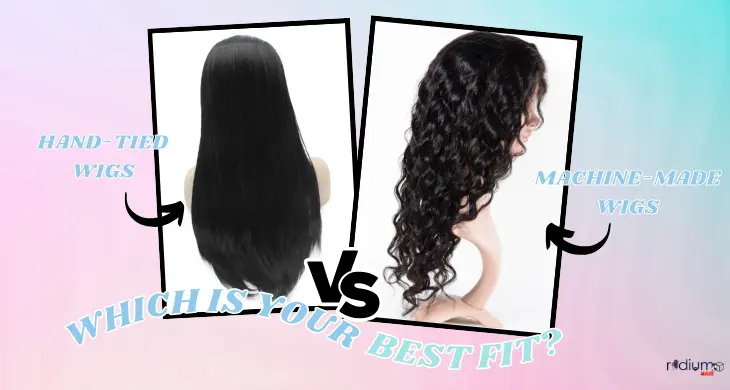Wigs have come a long way in recent years, offering versatile and natural-looking solutions for various hair needs. Whether you’re seeking a new style, dealing with hair loss, or simply want to experiment with different looks, wigs provide a fantastic way to express yourself. However, the abundance of choices can make the wig selection process overwhelming.
When it comes to wig construction, two primary options emerge: hand-tied wigs and machine-made wigs. Each type has its distinct features, benefits, and potential drawbacks, making it crucial to understand their differences. The decision between hand-tied and machine-made wigs ultimately boils down to personal preferences and requirements.
We’ll explore the world of wigs and unravel the complexities of hand-tied and machine-made wigs. By the end of this journey, you’ll be well-equipped to make an informed choice about the wig that best suits your style, comfort, and individual needs. So, let’s dive in and discover which wig type is your ideal fit.
Wig Basics: An Introduction to Wigs
Wigs, often associated with fashion and style, have a history that dates back thousands of years. They have served various purposes and held significance throughout different cultures and time periods. Here, in the section on “Wig Basics,” we will provide you with a comprehensive introduction to wigs, exploring their historical context and why they continue to hold importance in today’s world.
Historical Origins: Wigs have a rich and diverse history that spans across ancient civilizations. They were first documented in ancient Egypt, where both men and women used wigs to protect their heads from the scorching sun. These early wigs were made from natural materials, such as human hair and palm leaves, and they were often elaborately styled to represent social status.
Symbol of Status: Throughout history, wigs have been symbols of social status, prestige, and power. In ancient Rome, for example, senators and noblemen wore elaborate wigs as a sign of their authority. During the 17th and 18th centuries, wigs became highly fashionable in Europe, particularly among the French aristocracy. The wigs of this period, known as “periwigs” or “periwigs,” were characterized by their opulence and grandeur.
Cultural Significance: Wigs have played crucial roles in various cultures and religions. In the Jewish faith, Orthodox Jewish women often cover their natural hair with wigs, called “sheitels,” as a sign of modesty. In some African cultures, tribal leaders and elders wear wigs as a symbol of wisdom and authority. Additionally, wigs are integral in traditional Japanese theater, like Kabuki and Noh, where they are used to represent different characters and emotions.
Modern Usage: In the contemporary world, wigs have evolved from being symbols of power and social status to being versatile tools for self-expression, fashion, and addressing specific needs. People use wigs for various reasons, including as fashion accessories, for theatrical performances, to cope with hair loss due to medical conditions, or simply to change their appearance temporarily.
Key Differences Between Hand-Tied and Machine-Made Wigs:
Wigs come in a multitude of styles, materials, and construction methods. Two prominent techniques used in wig making are hand-tied and machine-made. Each method offers distinct advantages and characteristics that cater to various needs and preferences. In this section, “Construction Techniques,” we will delve deep into the significant disparities between hand-tied and machine-made wigs, allowing you to make an informed choice based on your unique requirements.
Hand-Tied Wigs: Craftsmanship at Its Finest
Hand-tied wigs are synonymous with meticulous craftsmanship. Each hair strand is individually tied to the wig cap by skilled artisans. This intricate and time-consuming process results in a wig that closely replicates the natural growth and movement of real hair. The key features of hand-tied wigs include:
- Realism: Hand-tied wigs offer the most realistic appearance. The hair appears to grow directly from the scalp, providing a natural look and feel. These wigs are virtually indistinguishable from one’s biological hair.
- Comfort: The delicate hand-tying process ensures that the wig is incredibly lightweight, breathable, and comfortable to wear. The construction allows for proper air circulation, reducing heat and discomfort.
- Versatility: Hand-tied wigs can be styled in numerous ways. The hair moves freely, making it possible to part, style, and even tie the hair up just like real hair.
- Durability: While hand-tied wigs are exceptionally realistic and comfortable, they may require more care and maintenance due to their delicate construction. Proper care can extend their lifespan.
Machine-Made Wigs: Precision and Efficiency
Machine-made wigs, as the name suggests, are created using automated processes. Multiple wefts of hair are sewn onto the wig cap by machines, resulting in a quicker and more cost-effective production. Key characteristics of machine-made wigs include:
- Affordability: Machine-made wigs are often more affordable than their hand-tied counterparts. This makes them an accessible option for those looking for a budget-friendly solution.
- Consistency: The machine-based construction ensures uniformity in the wig’s appearance and structure. Each wig of the same style will look nearly identical.
- Ease of Care: Machine-made wigs typically require less maintenance compared to hand-tied wigs. They are resilient and hold their shape well.
- Style Retention: Machine-made wigs are known for their ability to maintain the initial style and shape. This is particularly useful if you prefer a specific look that doesn’t require frequent restyling.
Maintenance and Care: Hand-Tied vs. Machine-Made Wigs
Maintaining the quality and appearance of your wig is essential to ensure it continues to look beautiful and serve you well. Proper care and maintenance are crucial regardless of whether you choose a hand-tied or machine-made wig. In this section, we’ll provide valuable insights into the maintenance and care routines for both types of wigs.
Hand-Tied Wig Care: Gentle Handling for Longevity
Hand-tied wigs are known for their delicate construction and exceptional realism. To keep them looking their best, follow these care guidelines:
- Daily Care: Gently brush your wig daily with a specialized wig brush. Start from the tips and work your way up to avoid tangles.
- Washing: Hand-tied wigs should be washed every 7-10 wearings, or when they appear dirty. Use a mild, sulfate-free wig shampoo and lukewarm water. Submerge the wig and gently agitate it, avoiding unnecessary rubbing or wringing.
- Styling: Style your hand-tied wig with heat-styling tools that have a low heat setting. Avoid excessive heat, as it can damage the wig’s delicate fibers.
- Storage: When not in use, store your hand-tied wig on a wig stand or in a cool, dry place, away from direct sunlight. This helps maintain its shape and prevents tangling.
Machine-Made Wig Care: Simplicity and Durability
Machine-made wigs offer practicality and affordability. Follow these maintenance and care tips to keep them looking their best:
- Daily Care: Use a wig brush to gently detangle your machine-made wig daily. Start at the tips and work upward.
- Washing: Machine-made wigs should be washed every 10-15 wearings. Use a mild wig shampoo and cool water. Gently agitate the wig, avoiding excessive friction.
- Drying: After washing, blot the wig with a towel to remove excess water.
- Styling: Machine-made wigs can tolerate heat styling, but it’s essential to use low to medium heat settings to avoid damage. Always use a heat protectant product.
- Storage: When not in use, store your machine-made wig on a wig stand or in a cool, dry location. Avoid exposure to direct sunlight, as it can cause color fading.
General Care Tips for All Wigs:
- Avoid exposing your wig to high temperatures, including stoves, ovens, and open flames.
- Be cautious around hot, humid conditions, as excessive moisture can affect the wig’s fibers.
- If your wig has a lace front or delicate parts, avoid using adhesive products that can damage the lace or mesh.
Making Your Decision:
When you embark on the journey to choose the perfect wig, you’ll find a wide array of options and considerations to navigate. To ensure you make the best decision, here are some practical tips and factors to keep in mind:
1. Wig Type:
- Consider whether you prefer a hand-tied or machine-made wig. Hand-tied wigs are renowned for their realism and comfort, while machine-made wigs offer durability and affordability.
2. Cap Construction:
- Explore the different cap constructions, such as lace front, full lace, monofilament, and classic caps. Each has its unique benefits in terms of comfort, realism, and styling options.
3. Material:
- Evaluate the type of hair used in the wig. Human hair wigs provide the most natural appearance, while synthetic wigs are easier to maintain and typically more affordable.
4. Style and Length:
- Think about the hairstyle and length you desire. Wigs come in a variety of styles, from short and chic to long and flowing.
5. Lifestyle and Activities:
- Consider your daily routine and activities. If you lead an active lifestyle, a machine-made wig may be more practical. Hand-tied wigs are perfect for special occasions and those who prioritize comfort.
6. Budget:
- Determine your budget for a wig. Hand-tied wigs are typically more expensive due to their craftsmanship, while machine-made wigs offer budget-friendly alternatives.
7. Maintenance:
- Hand-tied wigs require more delicate care, while machine-made wigs are generally easier to maintain.
8. Personalization:
- Assess how much you’d like to customize your wig. Hand-tied wigs offer more styling flexibility, allowing you to part the hair in any direction and style it to your liking.
Frequently Asked Questions:
Q1: What is the primary difference between hand-tied and machine-made wigs?
A1: The key difference lies in the construction. Hand-tied wigs feature individual hair strands meticulously hand-knotted to a lace cap, providing exceptional realism. Machine-made wigs are created with rows of wefts sewn into the cap, offering durability and affordability.
Q2: Which type of wig is more comfortable for all-day wear?
A2: Hand-tied wigs are often considered more comfortable due to their lightweight and breathable construction. They conform closely to the scalp, making them suitable for extended wear.
Q3: Do hand-tied wigs require more maintenance than machine-made wigs?
A3: Yes, hand-tied wigs demand more careful maintenance. They should be handled gently to preserve their delicate structure and appearance. Machine-made wigs are generally more durable and require less meticulous care.
Q4: Can I style hand-tied wigs more flexibly than machine-made wigs?
A4: Yes, hand-tied wigs offer greater styling versatility. You can part the hair in different directions and style it to your preference, providing a more natural and customizable look.
Conclusion:
Selecting the perfect wig, whether hand-tied or machine-made, is a matter of aligning your choice with your unique lifestyle and needs. Both types offer distinct advantages, catering to different preferences and requirements.
Hand-tied wigs excel in terms of realism and comfort, making them ideal for everyday elegance, sensitive scalps, special occasions, and personalization. They provide a lifelike appearance and the ability to style the hair as desired, ensuring a polished and sophisticated look.
Machine-made wigs, on the other hand, are known for their practicality and durability. They are well-suited for active lifestyles, everyday wear, and those seeking a budget-friendly option. While they may require less maintenance, they offer versatile styling and a hassle-free approach to hairdos.



